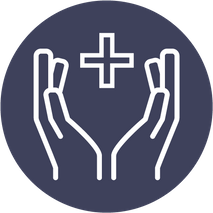Physical therapy for medial epicondylitis
AT EVOLVE
Physical therapy for medial epicondylitis
HOW CAN PHYSICAL THERAPY ADDRESS MEDIAL EPICONDYLITIS?
Medial epicondylitis of the elbow is a tendonitis of the forearm muscles where they attach at the inner elbow. This condition can result in pain, weakness or discomfort in the elbow, wrist and forearm and often interferes with sport and daily activities. Repetitive movements that stress these tendons are usually the cause of medial epicondylitis. A carefully prescribed rehabilitation program is an excellent strategy to reduce pain, improve tendon stiffness and resilience and help you return to the activities you need and love to do.
WHAT DOES PHYSICAL THERAPY TREATMENT FOR MEDIAL EPICONDYLITIS LOOK LIKE?
Physical therapy treatments for medial epicondylitis aim to reduce pain and discomfort in the tendons, improve tendon health and help restore your prior activity level. My team of therapists and I will start by getting to know your concerns and goals and performing a thorough physical exam to determine the extent of your symptoms while identifying other impairments that may have contributed to the development of this condition. Next, we will create a treatment plan that might include manual therapy on the tendons themselves, modalities and exercises performed in the clinic as well as exercises performed by you in your home as part of a home exercise program.
WHEN WILL I BEGIN TO SEE RESULTS?
With regular attendance and participation in physical therapy, many of our patients begin to experience a reduction in symptoms like pain and stiffness within a few weeks. Because other impairments like muscle weakness, nonoptimal movement patterns or reduced flexibility may have contributed to the development of medial epicondylitis, it often takes longer to address all of the underlying factors. If you have been taking time off from your favorite activities, your therapist will help you resume them in a graded fashion while you continue to address tendon health and other contributing factors. Achieving long-lasting results may take some time, but dedication to your program will not only help you achieve these results but will help to decrease the likelihood of symptoms recurring in the future.
WHAT IS MEDIAL EPICONDYLITIS?
The piriformis muscle is a small, pyramidal-shaped muscle deep in the buttock near the center. It arises from the front side of the sacral bone at the base of the spine and extends across the buttock to attach at the top of the femur near the hip. It lies beneath the biggest gluteal muscle called the gluteus maximus. This muscle is a rotator of the hip. It rotates the hip internally or externally depending on the position of the hip. It also helps with stability at the hip.
The sciatic nerve is a bundle of nerve fibers that originate from the base of the spine and innervates many of the leg and foot muscles. Generally this nerve runs just beneath the piriformis muscle exiting the pelvis below the belly of the muscle but anatomical variations exist wherein the nerve travels over or through the muscle belly of the piriformis and sometimes even splits around it. When piriformis syndrome is thought to be caused by these anatomical anomalies of nerve orientation it is called primary piriformis syndrome but it is unclear how often these variations in nerve position actually cause symptoms.
The most common type of piriformis syndrome occurs due to compression of the sciatic nerve by the piriformis muscle. This can occur due to several causes of which the most common include:
- Spasm or inflammation of the soft tissue around the buttocks due to trauma
- Muscle spasms of the piriformis following back surgery
- Piriformis muscle spasms due to lumbar or sacral joint pathology
- Piriformis muscle spasms due to overuse
- Shortening of the piriformis muscle due to biomechanical factors which compresses or irritates the sciatic nerve
Symptoms commonly associated with piriformis syndrome include:
- Pain felt deep in the buttocks
- Numbness in the buttock or down the leg
- Persistent low back pain that may be radiating
- Paresthesias/tingling or abnormal sensations in the buttock or leg
- Pain with prolonged sitting
- Tenderness to palpation over the area
- Increased pain after activities like stair climbing, bending, squatting or walking
End Injury Progression
Physical therapy for medial epicondylitis in elbow has proven to prevent injury, slow and even stop pain issues, improve performance, and reverse injury progression in many cases.
Relieve Pain
The movements used in this technique can target your entire body helping you to manage discomfort and pain during the course of your physical therapy treatments.
Improve Range of Motion
Posture awareness is an important area to focus on due to the fact that certain positions may cause you further discomfort and pain.
Restore Mobility
You can regain mobility and flexibility by taking part in the stretches and exercises as prescribed by your physical therapist.
PHYSICAL THERAPY TREATMENT FOR MEDIAL EPICONDYLITIS
If you decide to work with a physical therapist to help correct your medial epicondylitis issues, your entire treatment plan could consist of around 8-20+ different physical therapy sessions that will each last 60-90 minutes. Once you complete your customized physical therapy treatment plan, you will be able to continue to do the prescribed stretches and exercises utilized during your PT sessions yet in the comfort of your own home.
WHAT IS MEDIAL EPICONDYLITIS?
Medial epicondylitis is a musculoskeletal condition affecting tendons that attach along the inner or medial elbow. If you lay your forearm out on the table in front of you, palm up, the bony area on the inside of the elbow is known as the medial epicondyle. A sheath housing several tendons attaches to the bone here and acts as an anchor point for muscles that flex the elbow, wrist and hand, and rotate the forearm. The suffix itis indicates inflammation is present at the medial epicondyle. A more common name for medial epicondylitis is golfer’s elbow because repetitive movements such as those performed by golfers can lead to this condition.
While tendons are generally strong, they can become irritated or inflamed in response to certain activities. Repetitive wrist or elbow flexion or forearm rotation such as when golfing, can stress the tendons at their attachment point leading to the symptoms of medial epicondylitis. Here are some important facts about medial epicondylitis:
Tendons are built to withstand a great deal of force but repetitive stress that exceeds the tolerance of the tendon can lead to injury
Medial epicondylitis can have several causes:
- Ramping up a new activity too quickly
- Muscle length impairments around the wrist and forearm
- Muscle strength impairments around the wrist, forearm and elbow
- Inefficient movement patterns during sport or activity
- Biomechanical errors
Initially, the symptoms of pain and soreness may be caused by localized inflammation–known as tendonitis ( “itis” = inflammation )
Over time, if this condition becomes chronic, pain and related impairments are due more to tendon degeneration than inflammation
The best treatment for medial epicondylitis can depend on how acute or chronic the symptoms are as well as the underlying causes
SYMPTOMS OF MEDIAL EPICONDYLITIS
Medial epicondylitis can often be diagnosed based on symptom presentation. You may have medial epicondylitis if you experience any of the following symptoms:
- Pain, burning or aching on the inner elbow or along the forearm extending toward the wrist
- Pain on the inner elbow or forearm that worsens with flexion of the elbow, wrist or fingers or rotation of the forearm.
- Elbow stiffness
- Grip weakness
- Forearm weakness
Mill Basin (located in Harbor Fitness)
6161 Strickland Ave
Brooklyn, NY 11234
Monday: 7am-8pm
Tuesday: 7am-8pm
Wednesday: 8am-5pm
Thursday: 7am-8pm
Friday: 8am-1pm
Park Slope (located in Harbor Fitness)
550 5th Ave.
Brooklyn, NY 11215
Monday: 9am-8pm
Tuesday: 8am-6pm
Wednesday: 9am-8pm
Thursday: 8am-6pm
Friday: 8am-3pm
Gravesend
372 Avenue U
Brooklyn, NY 11223
Monday-Thursday: 8am-8pm
Friday: 8am-3pm
Kings Highway
945 Kings Highway
Brooklyn, NY 11223
Monday-Wed.: 12pm-8pm
Ready to take the next step to a healthier you?
Contact Us Today!
PHYSICAL THERAPY FOR MEDIAL EPICONDYLITIS
Need Physical therapy for medial epicondylitis in elbow?
Let our caring and compassionate physical therapists help you with relieving pain while getting you back on your feet comfortably.
Call now to schedule your first PT consultation free of charge.
Call: 1-718-690-3229







